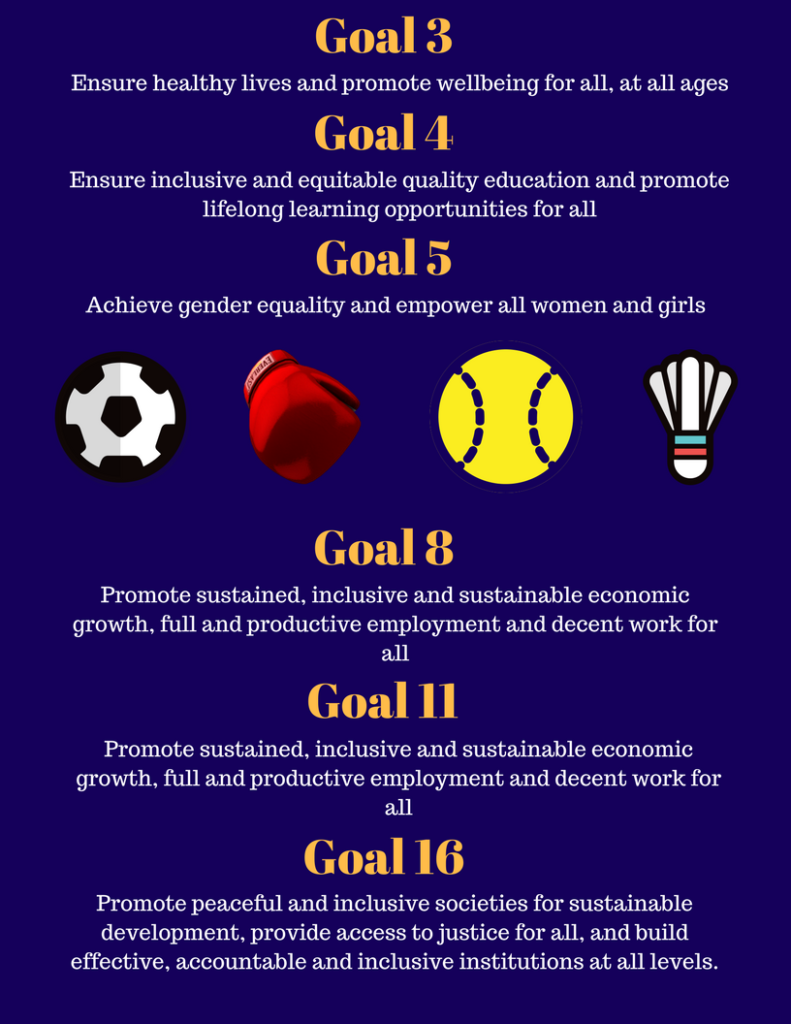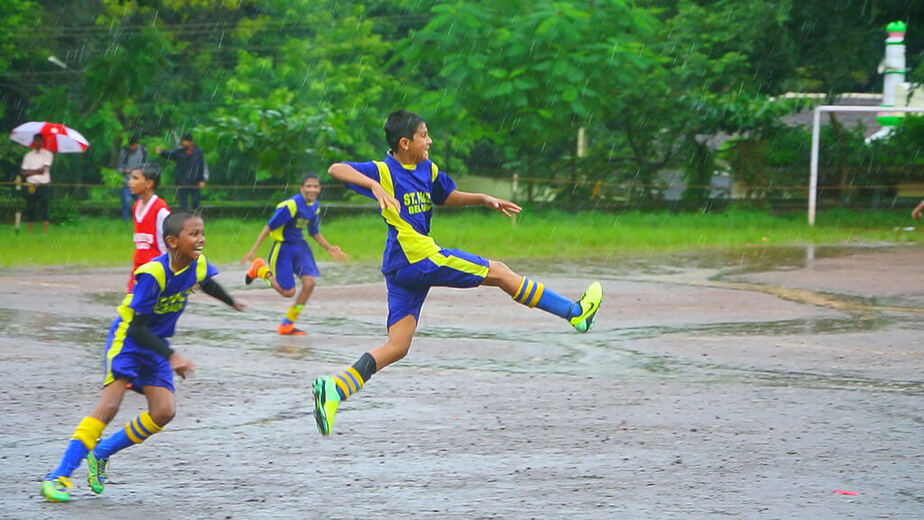Co-authored by Parkhee Rattan and Tanay Gokhale
Last month, the University of Basel awarded an honorary doctorate to one of Switzerland’s biggest sports stars, Roger Federer. Arguably the greatest player to have ever graced the tennis court, Federer’s doctorate in medical sciences was justified by “his function as a role model athlete, who encourages many people around the world to be physically more active and thus contributes to the promotion of health”. While empirically checking Federer’s influence on physical health is difficult to estimate, such a statement holds true in general; sport can be a great vehicle of development, in terms of both, physical health and community level development.
Why Do Sport and Development Go Hand in Hand?
Sport, apart from being a leisure activity, is a lot more in the day-to-day existence of communities. It often acts as a fun, non-threatening activity which – to say the least – is engaging and garners much interest on an individual level. Given its universal appeal, sport can provide a common platform to connect with and address the developmental needs of a community. Most importantly, sport demands and fosters a certain level of physical health and qualities such as dedication, discipline, and teamwork, which go hand in hand with development. A tool for engendering a sense of inclusion, spreading knowledge and awareness and enabling peer to peer communication, sport can build cooperation and trust within and between communities. These very qualities are what make sport a vehicle for development, something that has been recognized throughout the world:
Fighting for Peace in Rio De Janeiro: Fight for Peace, an NGO founded in 2000 works predominantly in the favelas of Rio in conjunction with the Brazilian Olympic Committee, operating through its Mare academy. Using boxing and martial arts, this programme is aimed at creating community champions from youth and coaches of the favelas, which are infamously known for violence, crime, and social exclusion.
Building resilience through sport in Jamaica: In a similar initiative, the Jamaican Olympics Committee, along with the International Committee of The Red Cross (ICRC) and the Jamaican Red Cross have lent their support to a sports-based programme intended for at-risk youth in the violence-stricken parts of Jamaica and to build resilience against financial, social or political barriers to development. Apart from reducing incidences of violence, the programme also provides opportunities to the participants by imparting IT, literacy and quantitative skills, which will help promote behavioural change and conflict management.
Brightening up the refugee camps in Ethiopia: The Ethiopian refugee camps make for a depressing place for a childhood; where children are often thrust into an unknown environment due to political conflict and are subject to the hardships that come with living in crowded, makeshift shelters. In such a setting, the International Olympics Committee has set up indoor and outdoor sports facilities in two refugee camps in Gambella, Ethiopia. These provisions are complemented by educational campaigns especially aimed at increasing awareness, empowering the disabled and imparting sexual education and awareness about reproductive health.
Colombia’s efforts at sport-centred development: To combat the internal conflict in Colombia – which has resulted in the displacement of more than three million people – the IOC, along with the UNHCR, the Colombian government and the Colombian Olympics Committee has sought to promote inter-community relations through sport. The primary targets of this programme are children and young adults who need to be made aware of the threats and consequences of drug consumption, violence and child labor among other problems.
The Convergence of Sport and the SDGs
The 2030 Sustainability Agenda, adopted by the world in 2015 revolves around the 17 Sustainable Development Goals or the SDGs. This Agenda – wherein nations strive to achieve the SDGs to the best of their ability – also recognize the merit of sport as a means of attaining the goals. An analysis conducted by the Commonwealth Secretariat has revealed that there is a strong link between sport and six of the 17 SDGs (shown below); not only are sports-based strategies applicable in these areas, but they might also prove to be cost-efficient and practical.

The Aussie Way
Australia is a case worth studying; a sport for development scheme has been implemented by the Australian Sports Commission (ASC) and the Australian Agency for International Development. This programme, titled Development-through-sports was instituted with the following outcomes in mind:
To improve physical health to reduce threat of Non-Communicable Diseases (NCDs); apart from the health benefits of physical activity which is necessary for sports, sports are also well-poised to avoid the four behavioral risk factors associated with NCDs: unhealthy diets, physical inactivity, tobacco use and harmful use of alcohol. While sport eliminates the first of them directly, it can also be used to raise awareness about the rest.
To improve the quality of life for people with disabilities; people with disabilities are quite vulnerable and disadvantaged not just economically, but socially as well, as they are most likely to be excluded from social activities. In tackling this issue, research suggests that spot can help on two levels. On the individual level, sport leads to a feeling of inclusion and enables communication with other members of the society, which in turn increases confidence and self-esteem. Not to mention the good that comes from the physical benefits of engaging in sport. On the larger community level, sport can be a far-reaching platform through which issues of social exclusion and prejudices can be addressed.
To improve gender equality and empowerment of women; sport has shown to be an empowering force for women as it helps prevent disorders and problems like osteoporosis, breast cancer and depression, which often plague women’s health and hence development. Moreover, participation in sport enables women to share an equal platform with men and helps challenge established gender norms, contributing to women’s self-esteem and increasing their inclusion in mainstream society. Sport also acts as a great normalizer, wherein the men of the community see the women as equals who are capable of whatever they wish to participate in. Such a friendly, yet competitive interaction also presents women with a chance to learn about leadership and decision-making. In a way, sport is seen by women to be an entry point into the higher rungs of communal decision-making activities.
To increase community cohesion; communities as a whole benefit greatly from sport. The bonds that are made on the field often stick off the field too. Another perspective is that sport ensures that the members of the community spend their time in meaningful activity, as against engaging in anti-social behaviour. Most importantly, sport helps inculcate the values of prudent decision making and responsibility in a light-hearted manner, which primes the members of the community for its application in their day-to-day lives, leading to a more harmonious existence.
The Development through Sports campaign also complements other development plans in Australia. For example, the Development For All is an aid programme with a focus on bringing about greater income equality through the inclusion of disabled as well as other disadvantaged groups into mainstream society. Additionally, the Health-for-Development strategy focuses on improved public health systems, which can be used in tandem with community-based sports events to improve the quality of life of Australian citizens.
So…More Play Time?
Well, yes. Sport is a well-documented mechanism for both, individual and communal development. It has the ability to bring people together and to create a more inclusive community. India has also seen the introduction of actors, like YUWA, that believe in the power of sport, and are making a great difference. With sport slowly making its way to the main stage in terms of global development strategies, India would do well to include innovative sport-driven solutions in its age-old battle for development.
One does tend to wonder, however, as to the actual effects of such programs. Sure, the theory checks out. But the best-laid plans can go haywire; while a football game can bring communities together, it can also spark a war. Only further explorations into the effect of sport-led strategies – maybe through case study analysis or community stakeholder engagement – could shed light on how effective these strategies are. The challenges are manifold. How would you assess the effect of a strategy without making normative assumptions about the assessing criteria? How would you isolate the effect of sports from other exogenous factors? What if the benefits do not outweigh the monetary and logistical costs of the programme itself? Having said that, any conclusion can be reached only after the experiment is conducted, and the case for sport-led development strategies is a strong one.
Featured image courtesy Julian Correa






